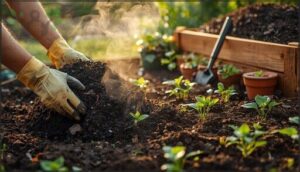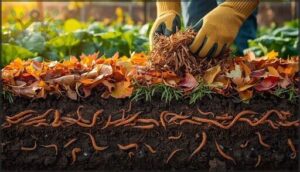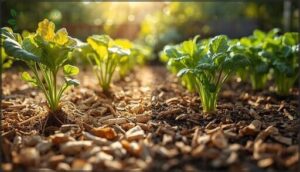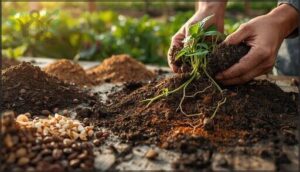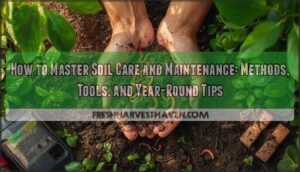This site is supported by our readers. We may earn a commission, at no cost to you, if you purchase through links.
Your garden soil isn’t just dirt—it’s a living ecosystem that determines whether your plants flourish or flounder. The texture you feel when you squeeze a handful, the color you see when you dig down a few inches, and the way water moves through it all tell a story about what’s happening beneath the surface.
Most gardeners inherit whatever soil came with their plot, but here’s the good news: you don’t have to settle for what you’ve got. With the right garden soil improvement tips, you can transform even the most stubborn clay or lifeless sand into rich, productive ground that feeds your plants season after season.
Table Of Contents
- Key Takeaways
- Assess Your Garden Soil Type
- Boost Soil Health With Organic Matter
- Improve Soil Fertility With Natural Amendments
- Enhance Soil Structure and Aeration
- Sustainable Practices for Lasting Soil Quality
- Frequently Asked Questions (FAQs)
- How can i Improve my soil?
- What makes a good garden soil?
- How do I care for my garden soil?
- How can I improve my soil’s nutrient supply?
- What is the key to healthy soil?
- When is soil improvement a good idea?
- When is the best time to test soil?
- How do soil microorganisms improve plant health?
- What causes nutrient lockout in garden soil?
- How often should compost be added annually?
- Conclusion
Key Takeaways
- Start by assessing your soil’s texture and structure through simple hands-on tests like the ribbon test and earthworm counts, since understanding what you’re working with guides every improvement decision you make.
- Build soil health by adding organic matter like compost and aged manure annually, which can boost water retention by 2.5 times in sandy soils and increase phosphorus levels by up to 340% compared to synthetic fertilizers alone.
- Fix your soil’s pH between 6.0 and 7.5 through targeted amendments like lime for acidic soils or sulfur for alkaline conditions, because plants can’t access nutrients when pH levels fall outside their ideal range.
- Protect your investment with sustainable practices like cover crops and mulching, which can cut soil erosion by 75%, reduce watering needs by a third, and increase yields by 27-48% compared to repeated single-crop planting.
Assess Your Garden Soil Type
Before you improve your soil, you need to know what you’re working with. Understanding your soil type helps you make smart decisions about amendments and care.
Let’s look at three practical ways to assess your garden soil and set yourself up for success.
Identifying Soil Texture (Sand, Silt, Clay, Loam)
How can you tell what kind of soil you’re working with? Start by rubbing moist soil between your fingers. Sand feels gritty—particles range from 0.05 to 2 millimeters. Silt feels smooth, measuring 0.002 to 0.05 millimeters. Clay feels sticky, with particles smaller than 0.002 millimeters. A key element is understanding soil particle classification.
Try the ribbon test: squeeze damp soil into a ribbon. Sandy soils crumble quickly, while clay soils form ribbons longer than 2 inches.
How Soil Structure Impacts Plant Growth
Knowing your texture is just the beginning—soil structure controls whether your plants thrive or struggle. Pore spaces between aggregates hold air and water, supporting healthy root aeration and soil drainage. When compaction squeezes those spaces, plant roots can’t breathe properly. Think of it like this:
- Compaction cuts corn yields by 6% to 34%
- Poor soil structure blocks oxygen to plant roots
- Damaged aggregate stability reduces water dynamics
- Low redox status in flooded soil stresses roots
- Good soil aeration = stronger growth and better harvests
Good soil fertility can reduce compaction effects.
Visual and Physical Tests for Soil Assessment
Beyond texture, hands-on tests reveal deeper truths about your soil. The ribbon test stretches moistened soil between your fingers—ribbons under one inch mean sandy loam, over two inches signal clay.
A slake test drops dry soil crumbs in water; rapid collapse shows weak structure.
Count earthworms in a cubic foot (ten or more is excellent). Check soil color for organic matter and observe infiltration rate during watering.
Boost Soil Health With Organic Matter
Organic matter is the foundation of thriving garden soil. It improves structure, feeds beneficial microbes, and supplies essential nutrients your plants need to grow strong.
Let’s look at the best organic materials to add and which ones you should avoid.
Benefits of Adding Compost and Aged Manure
Adding compost and aged animal manure transforms your soil by building organic matter that fuels nutrient cycling and boosts microbial activity. These amendments strengthen soil structure, increasing water retention by up to 2.5 times in sandy conditions.
Compost supplies slow-release nutrients while supporting carbon sequestration. Regular applications can raise soil fertility dramatically—in some trials, phosphorus levels jumped 340% compared to synthetic fertilizers alone.
Compost delivers slow-release nutrients and can boost phosphorus levels by 340% compared to synthetic fertilizers alone
Using Shredded Leaves and Plant Clippings
Shredded leaves break down faster than whole fallen leaves, supplying nitrogen, phosphorus, and potassium within a single season. Leaf decomposition gradually releases clipping nitrogen while improving soil structure.
Apply organic matter as mulch in 5–8 cm layers to boost moisture retention and reduce temperature swings. This sustainable mulching approach enriches your garden naturally.
Avoid clippings treated with herbicides—herbicide concerns are real, as carryover can harm sensitive plants.
Avoiding Fresh Wood Chips and Sawdust
While fresh wood chips make excellent pathway mulch, you’ll want to keep them away from your vegetable beds. Their high C:N ratio—often 125:1 or more—triggers nitrogen immobilization as microbes consume available nitrogen during decomposition. This drawdown can last an entire growing season, stunting plant growth.
Instead, follow management guidelines for soil improvement: use aged chips or reserve fresh material for perennial borders where organic matter builds soil health gradually.
Improve Soil Fertility With Natural Amendments
Once you’ve added organic matter, the next step is fine-tuning your soil with targeted amendments. The right additions can correct nutrient gaps, adjust pH, and create conditions where plants truly thrive.
Let’s look at how to choose and apply amendments that match your garden’s specific needs.
Choosing The Right Amendments for Your Soil
Your soil’s unique constraints determine which amendments work best. Start with soil testing to identify nutrient gaps and pH levels before you add compost or other organic matter. Here’s how to match amendments to your needs:
- Clay soils: Apply gypsum at 0.5–2 tons per acre to loosen structure without changing soil pH
- Sandy soils: Incorporate compost or aged manure to improve water retention and nutrient-holding capacity
- Acidic soils: Use lime at 1–3 tons per acre to raise pH and boost nutrient availability
- Contaminated soils: Blend biochar with compost to reduce heavy metal uptake in plants
Research shows organic amendments can increase crop yields by 27% compared to mineral fertilizers alone, with farmyard manure delivering even stronger results.
The long-term effects depend on application rates—usually 120–150 kg nitrogen per hectare optimizes soil biological activity while supporting steady plant growth. Amendment testing through certified labs helps you avoid guesswork and ensures you’re building healthier soil year after year.
Balancing Soil PH for Optimal Plant Growth
Your plants depend on the right pH to access nutrients from your soil. Most vegetables thrive between 6.0 and 7.5, where nitrogen, phosphorus, and potassium remain available. Soil testing reveals whether you need lime to raise acidic soil pH or sulfur to lower alkaline levels.
Here’s a quick guide:
| Soil Condition | Target pH | Amendment |
|---|---|---|
| Strongly acidic | 5.5–6.5 | Agricultural lime |
| Near neutral | 6.0–7.0 | Minimal adjustment |
| Strongly alkaline | 6.5–7.5 | Elemental sulfur |
Test every 2–3 years to maintain ideal pH ranges and prevent nutrient lockup.
Incorporating Animal Manure and Rock Minerals
Animal manure delivers concentrated nutrients your plants crave—chicken manure packs roughly three times more nitrogen per ton than cattle manure. Apply it safely and effectively:
- Use aged or composted manure to avoid nitrogen tie-up and pathogen risks
- Apply 120 days before harvest for crops touching soil; 90 days for sweet corn
- Combine rock phosphate or basalt with manure to boost potassium and micronutrient release by pairing organic matter with rock mineral nutrients
These soil amendments increase fertility naturally.
Enhance Soil Structure and Aeration
Your soil’s structure determines how well water, air, and nutrients reach plant roots. Whether you’re working with heavy clay that won’t drain or sandy soil that dries out too fast, you can make real improvements with the right approach.
Let’s look at three practical ways to improve your soil’s structure and aeration.
Loosening Clay Soils With Organic Matter
Working with clay soils can feel like wrestling with concrete, but adding compost or aged manure is your best strategy for Clay Soil Amendment. Research shows compost application increases total porosity by about 24% in clay, while manure boosts it by roughly 18%.
These Organic Matter Benefits help by forming stable aggregates that open up drainage channels. Even biochar at a 5% rate measurably improves soil structure, making dense ground more workable.
Thickening Sandy Soils for Better Water Retention
On the flip side, sandy soils drain so fast that roots barely have time to grab a drink. Research confirms that each 1% increase in organic matter boosts water capacity by roughly 2.3%, so you’ll want to work in 2 to 3 inches of compost annually into your top 6 to 8 inches. Biochar amendment and residue incorporation also help, while mulching options like rolled cover crops reduce evaporation:
- Apply compost application at 1 to 2 tons per acre yearly
- Mulch the soil surface with plant residues to slow water loss
- Mix in biochar at 3% to 5% by weight for better retention
- Leave crop leftovers on top to gradually build soil structure
Together, these steps transform sandy soils into moisture-holding growing beds, improving soil quality without complex interventions.
Preventing and Managing Soil Compaction
Compacted soil chokes roots and can knock 10% to 20% off your harvest. Traffic control keeps wheels on fixed lanes so up to 60% of your field stays loose, while raised beds eliminate in-bed compaction entirely.
Mulch effects include better aggregation and reduced sealing, and biological loosening through cover crops lifts macroporosity 33%.
Reducing tillage preserves aggregates, preventing soil compaction before it starts.
Sustainable Practices for Lasting Soil Quality
Building healthy soil isn’t just about what you add today—it’s about practices that keep your garden thriving year after year. Sustainable methods protect your soil’s structure while naturally boosting its fertility over time.
Let’s look at two key approaches that work with nature to maintain lasting soil quality.
Using Cover Crops and Crop Rotation
Planting cover crops during fallow periods and rotating what you grow are two powerful moves for long-term soil health. These practices work together to protect and rebuild your garden’s foundation.
The benefits of these practices are numerous. Some of the key advantages include:
- Nitrogen fixation – Legume cover crops like clover or vetch can add more than 50 kilograms of nitrogen per hectare, greatly reducing your fertilizer needs.
- Erosion control – Cover crops reduce soil loss by up to 75% and boost water infiltration more than six-fold in some gardens.
- Weed suppression – Dense cover crop canopies block light and limit weed growth, while crop rotation disrupts pest cycles.
- Yield stability – Rotating crops increases yields by 27% to 48% compared to planting the same thing repeatedly, improving soil structure and organic matter over time.
Mulching Techniques to Retain Moisture
Beyond cover crops, mulching techniques lock moisture in and cut your watering effort. Apply organic mulch at 0.25–0.50 kg/m² to boost soil water by up to 62%. This depth reduces evaporation by a third while allowing rainfall to infiltrate properly.
Wood chips, straw, and shredded leaves all work well. On slopes, full coverage cuts runoff by 25%, keeping water where your plants need it most.
Frequently Asked Questions (FAQs)
How can i Improve my soil?
Start adding organic matter—compost, aged manure, or shredded leaves—to your beds. This simple move strengthens the soil food web, boosts fertility, improves drainage, and fosters long-term soil health naturally.
What makes a good garden soil?
Good garden soil blends ideal soil texture—balanced sand, silt, and clay—with 40–60% pore space volume for air and water.
Organic matter levels of 5–10% improve soil structure, while soil pH ranges near 2–8 support nutrient-holding capacity.
How do I care for my garden soil?
Think of your soil like a living bank account—regular deposits of organic matter keep the balance healthy. Boost soil fertility and water holding capacity by adding compost, testing nutrients, and protecting the soil food web through mulching and minimal disturbance.
How can I improve my soil’s nutrient supply?
You can enrich soil nutrients by adding compost, aged animal manure, and cover crops. These organic matter sources boost nitrogen, phosphorus, and potassium while improving beneficial microbes that promote nutrient cycling and long-term soil fertility.
What is the key to healthy soil?
Healthy soil thrives on organic matter. It fuels microbial activity, creates stable aggregates for better water management, and unlocks nutrient availability.
When your soil composition fosters diverse life underground, fertility and structure improve naturally.
When is soil improvement a good idea?
Don’t wait for dirt to hit rock bottom—improve your soil when tests reveal pH imbalance signs, low organic matter, root restriction, or visual indicators like stunting.
Seasonal planning and soil testing guide targeted nutrients to boost soil fertility.
When is the best time to test soil?
Fall is ideal for seasonal soil testing because drier conditions make sampling easier and you’ll have time to interpret test results and apply amendments before spring planting begins.
How do soil microorganisms improve plant health?
Soil microbes drive nutrient cycling, converting organic matter into plant-available forms. Beneficial microbes suppress diseases, improve root growth, and boost stress tolerance.
These living soil organisms create ecosystem stability, making your garden healthier and more resilient.
What causes nutrient lockout in garden soil?
Like a locked door blocking entry, nutrient lockout prevents roots from absorbing food. pH imbalance, salt buildup, and chemical fixation create barriers. Metal interactions and aeration issues worsen the problem, requiring soil testing to identify deficiencies.
How often should compost be added annually?
Most gardens need compost once a year—a thin quarter-inch layer worked into soil.
Soil testing frequency matters: warm climates or hungry crops may justify twice annually, while high phosphorus readings mean skipping applications entirely.
Conclusion
The garden you envision next spring starts with the choices you make in the soil today. Each amendment you add, every cover crop you plant, and all the organic matter you work in builds momentum toward stronger roots and healthier harvests.
These garden soil improvement tips aren’t quick fixes—they’re investments in a living system that rewards patience. Start small, stay consistent, and watch your soil transform into the foundation your plants deserve.
- https://www.sciencedirect.com/science/article/pii/S0016706125003817
- https://pmc.ncbi.nlm.nih.gov/articles/PMC10702515/
- https://www.epa.gov/sustainable-management-food/benefits-using-compost
- https://soiltest.tfi.org/about/Key_Findings_2020
- https://www.sare.org/publications/cover-crops-ecosystem-services/cover-crops-improve-soil-conditions-and-prevent-pollution/


